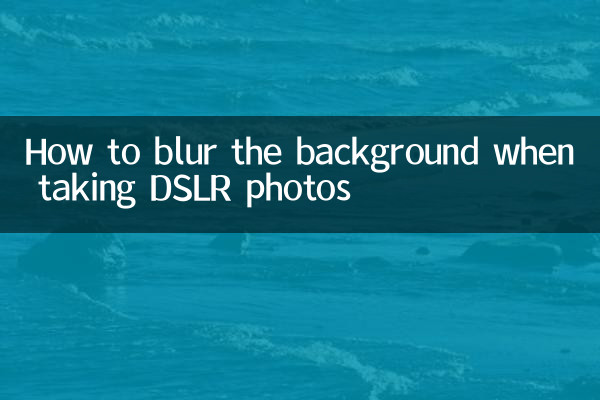How to blur the background when taking DSLR photos
In photography, background blur is a commonly used technique to highlight the subject and enhance the artistic feel of the picture. For SLR camera users, it is particularly important to master the method of background blur. This article will combine the hot topics and hot content on the Internet in the past 10 days to provide you with a detailed analysis of how to blur the background when taking SLR photos.
1. The principle of background blur

The core of background blur lies in "shallow depth of field", that is, the clear range in the picture is small and the rest is blurred. The following are the key factors that affect depth of field:
| factors | influence |
|---|---|
| Aperture size | The larger the aperture (the smaller the f-number), the shallower the depth of field and the more obvious the blur effect. |
| Focal length | The longer the focal length, the shallower the depth of field and the stronger the blur effect |
| Shooting distance | The closer the subject is to the camera and the further the background is from the subject, the better the blur effect will be. |
2. Specific methods to achieve background blur
1.Use a wide aperture lens
Choosing a lens with a larger aperture (such as f/1.4, f/1.8) is the most direct way to blur the background. A large aperture can significantly reduce the depth of field, making the background naturally blurry.
2.Adjust focus
Telephoto lenses (such as 85mm, 135mm) are easier to achieve background blur than wide-angle lenses. Even with a small aperture, a long focal length can bring obvious blur effects.
3.Control shooting distance
You can enhance the bokeh effect by moving closer to your subject and away from the background. For example, when shooting portraits, keep the subjects away from walls or trees, and the blur will be more obvious.
4.Choose the appropriate aperture mode
Use the aperture priority mode (A or Av mode) of the SLR camera to manually set the large aperture value and let the camera automatically adjust other parameters.
| shooting scene | Recommended aperture value |
|---|---|
| portrait photography | f/1.4 - f/2.8 |
| still life photography | f/2.8 - f/4 |
| Landscape photography (need to reduce blur) | f/8 - f/16 |
3. Common problems and solutions
1.What should I do if the blur effect is not obvious?
Check if the aperture is wide enough, or try lengthening the focus. If you use a kit lens (such as 18-55mm), it is recommended to upgrade to a large aperture fixed focus lens.
2.The subject is not clear after the background is blurred?
Maybe it's out of focus. Use single-point focus mode to make sure the focus point is on the subject.
3.How to balance blur and picture details?
Appropriately narrowing the aperture (such as f/2.8) can retain certain background details and highlight the subject.
4. Advanced skills
1.Use foreground blur
Adding foreground elements (such as leaves and flowers) in front of the subject and blurring them with a large aperture can increase the layering of the picture.
2.background light effect
Choose a background with some light source (such as night lights). Beautiful light spots will be formed under a large aperture, enhancing the atmosphere of the picture.
3.Enhanced blur in later stages
You can further optimize the blur effect through the blur tool of Lightroom or Photoshop, but you need to pay attention to the natural feeling.
5. Popular equipment recommendations
| Lens model | Maximum aperture | Applicable scenarios |
|---|---|---|
| Canon EF 50mm f/1.8 | f/1.8 | Entry-level portraits and still lifes |
| Nikon AF-S 85mm f/1.4G | f/1.4 | professional portrait |
| Sony FE 70-200mm f/2.8 GM | f/2.8 | telephoto, sports |
Through the above methods and techniques, you can easily master the trick of blurring the background when taking SLR photos. Whether it is portraits, still life or other subjects, reasonable blurring can make the work more attractive. With more practice, you can also achieve professional-level blur effects!

check the details

check the details